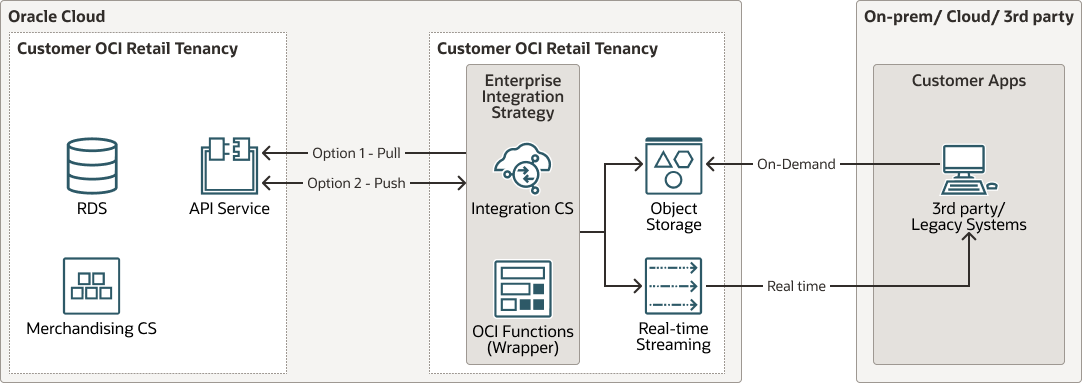Extract Retail Business Objects as Enterprise Canonicals from Oracle Retail
Oracle Retail Merchandising Foundation Cloud Service manages, controls, and performs day-to-day retail merchandising activities including purchasing, distribution, order fulfillment, retail inventory management, and financial close. These services may need to pass on retail business objects as enterprise canonicals to be consumed by other applications.
Retail business objects from Oracle Retail Merchandising Foundation Cloud Service can be extracted for use by third-party or legacy applications. This allows seamless integrations with legacy and non-oracle solutions.
Architecture
This architecture describes how data can be extracted and streamed to legacy and third-party applications. Use this architecture to extract retail business objects natively from Oracle Retail Merchandising Foundation Cloud Service.
The following diagram illustrates this reference architecture.
Retail business objects (for example, items and purchase orders) from Oracle Retail Merchandising Foundation Cloud Service can be made available to third-party and legacy systems using Oracle Cloud Infrastructure (OCI) cloud services. The most effective deployment options for an event-driven integration are:
- Option 1: Poll the publish service API to retrieve changed retail business objects within a time period (polling).
- Option 2: Subscribe to a publish service to receive data changes in near-real-time. The service can either publish the retail business object payload or only provide an event notification.
Once retail business objects are extracted these can be either stored locally using OCI Object Storage for build integration or they can be streamed using OCI Streaming, which provides a fully managed, scalable, and durable solution for ingesting and consuming high-volume data streams in real-time.
The architecture has the following components:
- Integration
Oracle Integration is a fully managed service that allows you to integrate your applications, automate processes, gain insight into your business processes, and create visual applications.
- Integration for SaaS
Oracle Integration is a fully managed service that allows you to integrate your applications, automate processes, gain insight into your business processes, and create visual applications.
Oracle Integration for SaaS, a streamlined version of Oracle Integration, gives you the features and benefits of Oracle Integration with a focus on SaaS.
- Object storage
Object storage provides quick access to large amounts of structured and unstructured data of any content type, including database backups, analytic data, and rich content such as images and videos. You can safely and securely store and then retrieve data directly from the internet or from within the cloud platform. You can seamlessly scale storage without experiencing any degradation in performance or service reliability. Use standard storage for "hot" storage that you need to access quickly, immediately, and frequently. Use archive storage for "cold" storage that you retain for long periods of time and seldom or rarely access.
- Streaming
Oracle Cloud Infrastructure Streaming provides a fully managed, scalable, and durable storage solution for ingesting continuous, high-volume streams of data that you can consume and process in real time. You can use Streaming for ingesting high-volume data, such as application logs, operational telemetry, web click-stream data; or for other use cases where data is produced and processed continually and sequentially in a publish-subscribe messaging model.
Recommendations
- Cloud Guard
Clone and customize the default recipes provided by Oracle to create custom detector and responder recipes. These recipes enable you to specify what type of security violations generate a warning and what actions are allowed to be performed on them. For example, you might want to detect Object Storage buckets that have visibility set to public.
Apply Cloud Guard at the tenancy level to cover the broadest scope and to reduce the administrative burden of maintaining multiple configurations.
You can also use the Managed List feature to apply certain configurations to detectors.
- Security Zones
For resources that require maximum security, Oracle recommends that you use security zones. A security zone is a compartment associated with an Oracle-defined recipe of security policies that are based on best practices. For example, the resources in a security zone must not be accessible from the public internet and they must be encrypted using customer-managed keys. When you create and update resources in a security zone, Oracle Cloud Infrastructure validates the operations against the policies in the security-zone recipe, and denies operations that violate any of the policies.
- Network security groups (NSGs)
You can use NSGs to define a set of ingress and egress rules that apply to specific VNICs. We recommend using NSGs rather than security lists, because NSGs enable you to separate the VCN's subnet architecture from the security requirements of your application.
